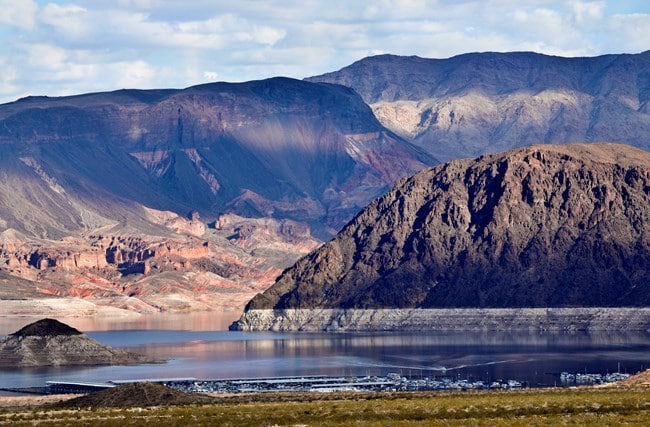A recent study co-authored by two Northern Arizona University researchers showed that targeted efforts to increase water efficiency could save enough water annually to fill Lake Mead. It could happen without significantly compromising economic production, jobs or tax revenue.
The study, published today in Environmental Research Letters, demonstrates that there is no one right answer to increase water efficiency—rather, there are dozens of right answers depending on region, industry and company. Ben Ruddell, the director of the FEWSION Project and director of the School of Informatics, Computing, and Cyber Systems (SICCS) and Richard Rushforth, an assistant research professor in SICCS, are co-authors on the study. Landon Marston, an assistant professor of civil and environmental engineering at Virginia Tech, led the study.
“What’s unique about this study is that we try to answer the question of how much water conservation can readily and affordably be achieved in each region and industry of the United States by looking at the conservation that has already been achieved by the water conservation leaders in each industry and region,” Ruddell said.
The study looked at how much water conservation can readily and affordably be achieved in each region and industry of the United States by looking at what conservation measures were already working and considering how much water is being used in every industry and throughout the country. Then the researchers ran statistics on that information, looking for areas that offer greater efficiency. The method controls for the differences in climate and technologies in different industries and states.
The study demonstrates how water users from farmers to manufacturers to service providers can collectively reduce their water consumption, both in their own processes and upstream throughout their supply chain, to reduce overexploitation of surface water and groundwater resources. It builds on earlier research evaluating potential water savings within the agricultural sector and in cities, applying a novel approach to water savings in the whole economy.
“The scope and detail of our study are unparalleled, and we believe this work will make a significant and timely contribution to the debate on how to conserve water while maintaining, or even increasing, economic activity,” Marston said. “We find that some of the most water-stressed areas throughout the U.S. West and South have the greatest potential for water savings, with about half of these water savings obtained by improving water productivity in the production of corn, cotton and alfalfa.”
The research argues that streamflow depletion throughout the West can be decreased on average by 6.6 percent to 23.5 percent without significantly reducing economic production or increasing costs. That is the other piece in this problem—that significant water savings can happen without significant harm to the economy. The majority of U.S. industries and regions can make the biggest contributions to water conservation by working with suppliers to reduce water use “upstream” in their supply chain; some large companies are already adopting this supply chain sustainability.
In the Southwest, which has a sizable agricultural industry as well as perennial water scarcity issues, the conversation about conservation has included ways to improve water use efficiency among farmers since the 1980s, but the study found that more improvement is readily achievable. The good news is that improvement is possible.
Although the study did not argue for specific conservation measures and water saving policies, it does offer a number of high-level recommendations. These included partnerships between large manufacturers, retailers and large metropolitan areas that are “downstream” in the water supply chain, which have more money and influence in making changes, and the large water users “upstream” to help organize and fund water conservation.
“This study argues that we can solve a large fraction of the U.S. water supply crisis simply by employing water conservation strategies that are already in routine use by the water productivity leaders in every industry and every region of the USA,” Ruddell said. “We don’t need a revolution in laws or technologies, or much more money, to achieve this. In the 21st century, water conservation has the potential to affordably boost and protect our national water supply in a big way, and avoid the need for hundreds of billions of dollars in taxing and spending on new water infrastructure to cope with drought and climate change.”
Heidi Toth | NAU Communications
(928) 523-8737 | heidi.toth@nau.edu




